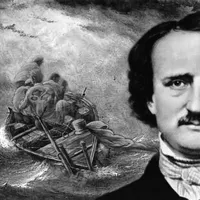NOTE
THE circumstances connected with the late sudden and distressing death of Mr. Pym are already well known to the public through the medium of the daily press. It is feared that the few remaining chapters which were to have completed his narrative, and which were retained by him, while the above were in type, for the purpose of revision, have been irrecoverably lost through the accident by which he perished himself. This, however, may prove not to be the case, and the papers, if ultimately found, will be given to the public.
No means have been left untried to remedy the deficiency. The gentleman whose name is mentioned in the preface, and who, from the statement there made, might be supposed able to fill the vacuum, has declined the task-this, for satisfactory reasons connected with the general inaccuracy of the details afforded him, and his disbelief in the entire truth of the latter portions of the narration. Peters, from whom some information might be expected, is still alive, and a resident of Illinois, but cannot be met with at present. He may hereafter be found, and will, no doubt, afford material for a conclusion of Mr. Pym's account. The loss of two or three final chapters (for there were but two or three) is the more deeply to be regretted, as it can not be doubted they contained matter relative to the Pole itself, or at least to regions in its very near proximity; and as, too, the statements of the author in relation to these regions may shortly be verified or contradicted by means of the governmental expedition now preparing for the Southern Ocean.
On one point in the narrative some remarks may well be offered; and it would afford the writer of this appendix much pleasure if what he may here observe should have a tendency to throw credit, in any degree, upon the very singular pages now published. We allude to the chasms found in the island of Tsalal, and to the whole of the figures upon pages 245-47 {of the printed edition—ed. }.
(Note: No figures were included with this text)
Mr. Pym has given the figures of the chasms without comment, and speaks decidedly of the indentures found at the extremity of the most easterly of these chasms as having but a fanciful resemblance to alphabetical characters, and, in short, as being positively not such. This assertion is made in a manner so simple, and sustained by a species of demonstration so conclusive (viz., the fitting of the projections of the fragments found among the dust into the indentures upon the wall), that we are forced to believe the writer in earnest; and no reasonable reader should suppose otherwise. But as the facts in relation to all the figures are most singular (especially when taken in connection with statements made in the body of the narrative), it may be as well to say a word or two concerning them all-this, too, the more especially as the facts in question have, beyond doubt, escaped the attention of Mr. Poe.
Figure 1, then, figure 2, figure 3, and figure 5, when conjoined with one another in the precise order which the chasms themselves presented, and when deprived of the small lateral branches or arches (which, it will be remembered, served only as a means of communication between the main chambers, and were of totally distinct character), constitute an Ethiopian verbal root-the root "To be shady,'—whence all the inflections of shadow or darkness. In regard to the "left or most northwardly" of the indentures in figure 4, it is more than probable that the opinion of Peters was correct, and that the hieroglyphical appearance was really the work of art, and intended as the representation of a human form. The delineation is before the reader, and he may, or may not, perceive the resemblance suggested; but the rest of the indentures afford strong confirmation of Peters' idea. The upper range is evidently the Arabic verbal root "To be white," whence all the inflections of brilliancy and whiteness. The lower range is not so immediately perspicuous. The characters are somewhat broken and disjointed; nevertheless, it can not be doubted that, in their perfect state, they formed the full Egyptian word. "The region of the south.' It should be observed that these interpretations confirm the opinion of Peters in regard to the "most northwardly" of the figures. The arm is outstretched toward the south.
Conclusions such as these open a wide field for speculation and exciting conjecture. They should be regarded, perhaps, in connection with some of the most faintly detailed incidents of the narrative; although in no visible manner is this chain of connection complete. Tekeli-li! was the cry of the affrighted natives of Tsalal upon discovering the carcase of the white animal picked up at sea. This also was the shuddering exclamatives of Tsalal upon discovering the carcass of the white materials in possession of Mr. Pym. This also was the shriek of the swift-flying, white, and gigantic birds which issued from the vapory white curtain of the South. Nothing white was to be found at Tsalal, and nothing otherwise in the subsequent voyage to the region beyond. It is not impossible that "Tsalal," the appellation of the island of the chasms, may be found, upon minute philological scrutiny, to betray either some alliance with the chasms themselves, or some reference to the Ethiopian characters so mysteriously written in their windings. "I have graven it within the hills, and my vengeance upon the dust within the rock."

